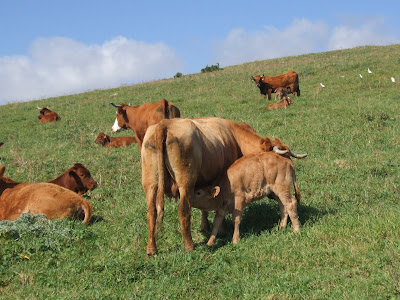How now, red cow?

Alcalá is surrounded by cattle, and not just the scary great black toros bravos - fighting bulls - bred around Medina Sidonia and destined to face Death in the Afternoon. This land produces some of Spain's finest beef. Drive out in any direction and you will see large herds of reddish-brown beasts with huge white horns, peacefully grazing or being rounded up by mounted vaqueros . There is usually a flock of cattle egrets in attendance, and occasionally a tiny calf just finding its feet. These are the raza retinta , our own native breed, and they are very special. The word retinta refers to their colour, which can range from chestnut red to dark brown. The breed Bos taurus Turdetanus (I kid you not) probably originated in North Africa, but has been in the Iberian peninsular since ancient times and can be seen in cave drawings. Today it is found mainly in Andalucia and Extremadura, though there are small herds in other parts of Spain including the Balearics. Retinta cattle



